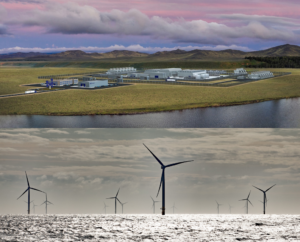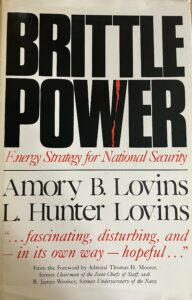Note: This post distills and extends ideas from our Nov. 1 post, The Carbon-Tax Nimby Cure.
From the East Coast to Idaho’s high desert, big green-energy investments are foundering.

Composite of (top) first U.S. SMR complex (NuScale facility, artist’s depiction) and (below) offshore wind farm (Orsted’s UK Hornsea facility). Neither was in line for more than token revenues tied to displaced carbon emissions. Both have been cancelled.
Just in the past week, Danish wind giant Orsted scuttled the 2,248-megawatt Ocean Wind farm it was developing off New Jersey’s Atlantic coast, while NuScale scrapped its planned 462-MW complex of six 77-MW small modular reactors (SMRs) near Idaho Falls.
Both ventures were viewed as door-openers to new forms of large-scale U.S. carbon-free green power. They would have contributed mightily to decarbonizing their respective grids, taking the place of fossil fuel electricity now spewing nearly 4 million metric tons of carbon dioxide each year.
Their demise, along with dimming prospects for Equinor’s 2,076-MW Empire Wind farm off Long Island, NY, suggest that the vaunted crossover point at which big green-energy investments will come seamlessly to fruition fast and hard enough to rapidly decarbonize our grids is receding.

The 1983 title denoted “hard energy” facilities like giant power stations and LNG terminals. Nowadays it also seems apt for big green-energy projects.
The causes are no mystery: supply bottlenecks, spiraling materials costs, 40-year-high interest rates, Nimby obstruction. Not all of these will necessarily persist, but suddenly the combination looks daunting. Big energy projects, once derided as “brittle” by energy guru Amory Lovins, are rife with negative synergies. Nimbys stretch project schedules and impose punishing interest costs, particularly on big wind farms, a phenomenon we wrote about a week ago in The Carbon-Tax Nimby Cure.
Alas, Joe Biden’s Inflation Reduction Act is not a panacea. IRA incentives primarily lift EV’s, rooftop solar, heat pumps, batteries and factories. They are not going to refloat stalled clean power projects. That push will have to come from somewhere else.
What a Robust Carbon Price Could Do for Green Energy
A robust carbon price could provide much of that push. Not a token price like RGGI’s $15, which is the per-metric-ton value of the 4Q 2023 permit price in the northeast US Regional Greenhouse Gas Initiative electricity generation cap-and-trade program; but $50 or more, preferably $100.
I’ve been calculating how much profit a robust carbon price could inject into clean-energy bottom lines. The numbers are so astounding that I checked and rechecked them. Here’s one: A $100/ton carbon price in NY would allow Empire Wind to charge an additional $200 million or more each year for its output. How? Because the tax would raise the “bid price” for natural gas-generated electricity, the dominant power source and thus the price-setter on the downstate grid by so much — $30 to $35 per MWh, I estimate — that Empire Wind’s 7.25 million MWh’s a year could extract an additional $240 million in its power purchase agreement with the NY grid operator.

Lots to see here. The dollar figures, including the $/MWh bottom lines, are derived off-screen. Added revenues will be less if gas generators lower their grid prices somewhat, but will be more if the methane fee enacted as part of the 2022 IRA comes into play.
Same goes for NuScale. I estimate that its Idaho SMRs could command an additional $100 million a year (less than for Empire Wind because the project is smaller and not all of its output will replace fossil fuels). This additional value equates to $29 per MWh — nearly the same, coincidentally, as the $31/MWh climb in costs since 2021 that triggered NuScale’s cancellation, according to a report by the anti-nuclear Institute for Energy Economics and Financial Analysis.
These added payments to clean-energy developers are not “subsidies.” They arise by slashing ongoing subsidies now enjoyed by fossil fuel providers and processors — in this case the methane-gas extractors and the electricity generators that burn the fuel — by subjecting these fuels to carbon pricing. The added payments will come about as the carbon price forces the gas generators to raise their sale price to the grid (to recoup their higher price to purchase the gas), which then creates room for Empire (or NuScale) to raise its prices.
Every cent of the carbon tax revenues will remain fully available for public purposes, whether to support low-income ratepayers, or invest in more clean energy or community remediation, or, our preference at CTC, as “dividend” checks to households. None of it needs to be earmarked to Empire or NuScale for them or other clean-power generators to rebuild their profit margins. The gainsharing comes about through pricing carbon emissions, not disbursing the carbon revenues.
Adios, Nimbys?
The Not In My Back Yard crowd wasn’t an apparent factor in NuScale’s downfall. (“Regulatory creep” was, but that’s a story for another time, not to mention one I dissected 40 years ago for the peer-reviewed journal Nuclear Safety.) But they certainly were for Ocean Wind in NJ and will be in NY if Empire Wind goes down the drain.
But here’s the thing: Not only would the added revenue allowed by the carbon price help return Empire Wind to the black. It would give Equinor, the developer, the wherewithal to spread so much largesse among the residents of Long Beach, LI (my hometown!) that they could subdue the Nimbys who have been able to hold up permitting by spreading scare stories about the routing of the project’s power cables underground. Nimby-ism solved, not by suasion (a fool’s errand) but by motivating the masses in the middle who evidently require more tangible inducements than saving the climate (or their beaches or homes).
Let’s Think Big
Ocean Wind, Empire Wind and NuScale are just a few examples of carbon-free projects that could again pencil out with robust carbon pricing. The question remains, how do we get there?
The point of this new analysis isn’t so much to tie clean energy to carbon pricing, but to enlist the political power and prestige of clean-energy entrepreneurs and developers on the side of carbon-tax advocacy.
As we noted in our previous (Nov. 1) post, during headier carbon-pricing times (2007 to 2011) the Carbon Tax Center attempted, alongside allies like Friends of the Earth, the Friends Committee on National Legislation, and Citizens Climate Lobby, to induce the American Wind Energy Association, the Solar Energy Industry Association and other green-tech trade groups to join us in advocating carbon taxing. We put out similar feelers to the Nuclear Energy Institute and the American Nuclear Energy Council. Getting the U.S. nuke lobby behind carbon taxing should have been a no-brainer, given that carbon taxes that monetized the climate value of nuclear power plants’ combustion-free electricity could have supplied mega-dollars to keep extant reactors solvent.

2010 redux: Equation at left signifying “Renewable Energy cheaper than Fossil Fuels” was a cleantech meme. Button on right, created by then-CTC senior policy analyst James Handley, was less prevalent. Time to meld the two?
No dice. We weren’t granted even one conversation with the nuclear folks. The wind and solar people, for their part, insisted that unending cost reductions through increased scale and efficiency, along with green power’s inherent magical appeal, would propel them past any obstacle. Why besmirch our Randian aura with energy taxes, they seemed to say, when our tech is going to usher in energy abundance and spare earth’s climate?
Things look different now. Big, carbon-free power ventures — the ones that everyone from governors and ambassadors to scientists and schoolkids are counting on to get us off fossil fuels — are beset by troubles: financial, logistical, cultural.
Without genuine carbon pricing that accords clean energy the economic rewards to which it’s entitled, too many large-scale green energy projects are going to come up short. As we asked in that earlier post: Will clean-power developers look at this week’s NJ and Idaho losses, among others, and decide that they need a carbon tax every bit as much as the climate does?
<!–
–>
- SEO Powered Content & PR Distribution. Get Amplified Today.
- PlatoData.Network Vertical Generative Ai. Empower Yourself. Access Here.
- PlatoAiStream. Web3 Intelligence. Knowledge Amplified. Access Here.
- PlatoESG. Carbon, CleanTech, Energy, Environment, Solar, Waste Management. Access Here.
- PlatoHealth. Biotech and Clinical Trials Intelligence. Access Here.
- Source: https://www.carbontax.org/blog/2023/11/10/gainsharing-carbon-taxes-can-put-clean-energy-back-in-the-black/




